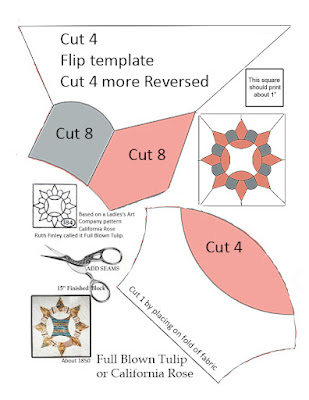One of my favorite patterns, this one offered a few years ago by
Molly at Fourth Corner Quilts.
Los Angeles County Museum of Art
They call it "Full Blown Tulip.
Red and green calico blocks alternate with a chintz
pillar print in a blending of two styles---two ways of looking at fabric.
Same pillar print from Winterthur Museum's collection
About 1840 the fashion for large-scale furnishing prints in a busy composition was
replaced by a trend to use smaller scale calico prints. The Full Blown Tulip blocks are
the new idea; the chintz becoming old fashioned.
Ruth Finley in the 1929 book Old Patchwork Quilts called the design
"Full Blown Tulip" with a photo of a Turkey red, green and chrome orange & yellow quilt:
The height of quilt fashion about 1850.
So how old is this rather complex design?
The earliest examples are variations in a quilt dated 1842 & 1843.

Philadelphia Museum of Art
Other date-inscribed examples:
1842-1844 Henry Ford Museum
Philadelphia, Bucks County & Chester County names
They call it a Reel Variation.
American Museum of Folk Art
1842-1843, Sarah Morrell
Lisa Erlandson Collection
1844 Sarah A White
Annapolis, Maryland
Michigan State University Collection
1845 Abraham Messler, Somerville, New Jersey
Messler was a minister in the Reformed Dutch Church.
1845 Album Sampler with Donoho & Young family
names, Maryland Historical Society
BlockBase+ patterns numbered 36xx
Probably some skillful piecers in the 1840s did not fit it into a square block but pieced it into another odd shape. As my computer program is BLOCKBase we fit it into a block---in a circle, but pieced edges might be better.
About 1950 from my collection
Online Auction
I redrew the BlockBase pattern for a 15-inch block.
Print on an 8-1/2" x 11" sheet.
In 1929 Ruby Short McKim published a pattern
in the Kansas City Star called Strawberry. She added an extra
seam in the petals.
BlockBase #3640
McKim's name from a mid-20th-c sampler.
A few years later an Oklahoma reader sent another version to the Star.
A real challenge. BlockBase #3637.
1938 Chicago Tribune version
Variations have many names. I'm not going to count them all. I've always liked Victoria's Crown, another Finley name, although I have no idea how old that name actually is.
Online Auction




























Hi Barbara. It always amazes me how much information you're able to gather on one particular pattern. Do you happen to know if the size, scale, and style of furniture happen to have an influence on the size of quilt blocks / patterns?
ReplyDeleteSize-as it involves arithmetic---is not my skill area. One thing--- in the chintz furniture panels we see in coastal Carolina quilts---the panel is designed to fit a chair cover.
DeleteActually, I was thinking of huge four-poster beds; however, I cannot recall exactly where I've seen them in my travels.
DeleteI’ve always liked this pattern. But have also been afraid to tackle it! Piecing all those curves seems quite intimidating! I liked the version by the reverend, using one fabric for each block, you could applique it instead. Might be easier. Of course then you’d lose all the fun pattern. Sigh. I’m reminded of an article I saw years ago in a quilt magazine. The author stated she’d seen one of these quilts when she was sick with a fever and all she saw were red/white radishes (must have been like the Chicago Tribune version). She called it a Full Blown Radish quilt!
ReplyDelete